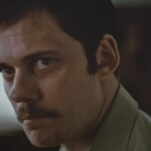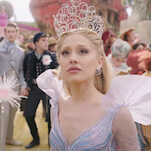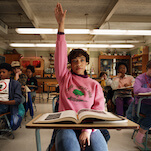Returning to wreak havoc via glowing supernatural fog during the town’s centennial celebration, these villains are, like Halloween’s Michael Myers, silent figures of death who are defined by their unyielding forward progress, as well as their skill with sharp weapons. Yet they’re less serial-killer scary than—as Carpenter himself says in the Blu-ray feature “Tales From The Mist”—E.C. Comics-style ghoulish. Framed by John Houseman telling rapt-with-attention kids the campfire legend of the wrecked ship, The Fog is a work of old-school spookiness, one that keeps gore to a minimum even as it delivers frighteningly effective kill sequences defined by swift edits and exaggerated reaction shots.
Regardless of those moments, the film primarily derives its creepiness from its milieu, a sleepy hamlet that Carpenter shoots as a series of evocative rocky cliffs and empty streets. Ominously moody, Antonio Bay is more of a character than the nominal protagonists of Carpenter and co-screenwriter/producer Debra Hill’s script. Attempting to avoid death at the hooks of undead mariners are Jamie Lee Curtis’ hitchhiker, Tom Atkins’ heroic town resident, Janet Leigh’s festivities organizer, and Adrienne Barbeau’s DJ—the last of whom issues a sultry-voiced radio warning from high atop her lighthouse station.
Those townsfolk’s particular stories make far less of an impact than Carpenter’s atmospheric visuals, which include an early montage of cars suddenly honking and chairs mysteriously moving, as well as Holbrook’s late, crucifix-aided confrontation with the fiends. While its themes of revenge, absolution, and salvation carry with them a distinctive Christian tinge, The Fog rests less on its archetypal return-of-the-repressed themes—and, in particular, its portrait of long-buried historical crimes rising back to the surface—than on its directorial staging and cinematographic framing. The latter is never more memorable than when, at the end of Houseman’s prologue tale, the camera rises upward into the darkness to reveal an amazing title-card cliffside view of the eerily expansive shoreline. And the former (highlighted in a nifty “Storyboard To Film” featurette that compares early sketches to final footage of the sailors’ first lethal appearance) is most impressive during the film’s finale, which finds the town’s principals attempting to fend off the murderous sailors in a church basement—a sequence that plays like a supernatural riff on Carpenter’s own Assault On Precinct 13.
Also new this week:
While Scream Factory gives loving home-video treatment to John Carpenter’s ghosts, Criterion does likewise for the undead specters of Guillermo del Toro’s The Devil’s Backbone, the Pacific Rim director’s 2001 Spanish-language tale of a haunted orphanage in Civil War-wracked 1939 Spain. Far less terrifying, Marilyn Monroe makes a Blu-ray splash via reissues of the noir-ish Niagara and sexy comedy Bus Stop. The Touch Of Mink finds Cary Grant romantically pursuing Doris Day, while more overt sexuality—albeit less scandalous now than it seemed upon its release—enlivens Anthony Mann’s superb 1958 film adaptation of God’s Little Acre. Erich von Stroheim’s lavish, epic Foolish Wives also gets the hi-def treatment, the better to marvel at the backlot-reproduced Monte Carlo sets that made it, in 1922, the most expensive cinematic production ever. Peggy Sue Got Married allows Francis Ford Coppola to get nostalgic with the time-travel tale of a housewife reliving her high-school years, and Gary Cooper fights legal injustice in Otto Preminger’s historical drama The Court-Martial Of Billy Mitchell. Finally, the redemptive Western Angel And The Badman features headliner John Wayne making his producing debut, and Love Me Tender provides the first big-screen role for the King himself, Elvis Presley.
A sparse new release slate includes Cloudburst, the story of two older lesbians absconding to Canada to get married; Black Rock, the tale of women on the run from men intent on hunting and killing them; and G.I. Joe: Retaliation, a gung-ho sequel—headlined by The Rock and Bruce Willis—that flees realism at every ludicrous turn.








































